Still new to android and even more to custom cursor adapter so I'm having trouble understanding how to prevent my listview from recycling views to prevent input from one edittext to show up in another when scrolled. I've seen on other post saying to change the name of convertview but how to do that I'm drawing a blank. I was hoping someone here would be able to give more details or example of how to do based of what code I've wrote so far.
public class editview extends ListActivity {
private dbadapter mydbhelper;
private PopupWindow pw;
public static int editCount;
public static ListView listView;
/** Called when the activity is first created. */
@Override
public void onCreate(Bundle savedInstanceState) {
super.onCreate(savedInstanceState);
mydbhelper = new dbadapter(this);
mydbhelper.open();
View footer = getLayoutInflater().inflate(R.layout.footer_layout, null);
ListView listView = getListView();
listView.addFooterView(footer);
showResults();
}
//Populate view
private void showResults (){
Cursor cursor = mydbhelper.getUserWord();
startManagingCursor(cursor);
String[] from = new String[] {dbadapter.KEY_USERWORD};
int[] to = new int[] {R.id.textType};
ItemAdapter adapter = new ItemAdapter(this, R.layout.edit_row, cursor,
from, to);
adapter.notifyDataSetChanged();
this.setListAdapter(adapter);
editCount = adapter.getCount();
}
//footer button
public void onClick(View footer){
final MediaPlayer editClickSound = MediaPlayer.create(this, R.raw.button50);
editClickSound.start();
startActivity(new Intent("wanted.pro.madlibs.OUTPUT"));
}
//custom cursor adapter
class ItemAdapter extends SimpleCursorAdapter {
private LayoutInflater mInflater;
private Cursor cursor;
public ItemAdapter(Context context, int layout, Cursor cursor, String[] from,
int[] to) {
super(context, layout, cursor, from, to);
this.cursor = cursor;
mInflater = LayoutInflater.from(context);
}
static class ViewHolder {
protected TextView text;
protected EditText edittext;
}
@Override
public View getView(int position, View convertView, ViewGroup parent) {
ViewHolder holder;
if (convertView == null) {
convertView = mInflater.inflate(R.layout.edit_row, null);
holder = new ViewHolder();
holder.text = (TextView) convertView.findViewById(R.id.textType);
holder.edittext = (EditText) convertView.findViewById(R.id.editText);
convertView.setTag(holder);
} else {
holder = (ViewHolder) convertView.getTag();
}
cursor.moveToPosition(position);
int label_index = cursor.getColumnIndex("userword");
String label = cursor.getString(label_index);
holder.text.setText(label);
return convertView;
}
}
Changed it to
class ItemAdapter extends SimpleCursorAdapter {
private LayoutInflater mInflater;
private Cursor cursor;
Map<Integer, String> inputValues = new HashMap<Integer, String>();
public View getView(final int position, View convertView, ViewGroup parent) {
....
ViewHolder holder;
if (convertView == null) {
convertView = mInflater.inflate(R.layout.edit_row, null);
holder = new ViewHolder();
holder.text = (TextView) convertView.findViewById(R.id.textType);
holder.edittext = (EditText) convertView.findViewById(R.id.editText);
convertView.setTag(holder);
} else {
holder = (ViewHolder) convertView.getTag();
}
cursor.moveToPosition(position);
int label_index = cursor.getColumnIndex("userword");
String label = cursor.getString(label_index);
holder.text.setText(label);
String oldText = inputValues.get(position);
holder.edittext.setText(oldText == null ? "" : oldText);
holder.edittext.addTextChangedListener(new TextWatcher(){
public void afterTextChanged(Editable editable) {
inputValues.put(position, editable.toString());
}
but it is recycling after all edittext have data. Tried using holder.edittext.setText(oldText) but same effect.


